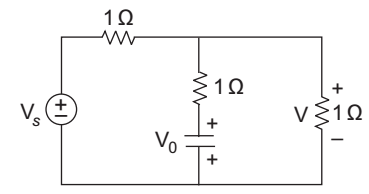Correct Option: C
If we consider the circuit carefully we see that there are two voltage source present in the circuit and if we have to calculate the net voltage in a particular resistance it can be easily calculated by using superposition theorem.
Case I. When Vs = 8u (t) = 8 V source is treated, the equivalent circuit becomes.
Apply voltage divides method, we get
| I = | | V | =
| 8 | | 8 | =
| 16 | amp
|
Req | 1 + 1 || 1 | 1 + (1 / 2) | 3 |

I 1 = 16 3 × 1 2 = 8 3 amp
Case II. When | V
0 | = 5 V source is treated, the equivalent circuit becomes.
| I′ 2 = | | V | =
| 5 |
|
Req | 1 + 1 || 1 |
| I′ 1 = I′2 × | | 1 | =
| 10 | x
| 1 |
|
1 + 1 | 3 |
2 |

The net current in 1 Ω resistance
| = I1 + I′ 1 = | | 8 | +
| 5 | =
| 13 | amp.
|
3 | 3 |
3 |
| Voltage drop across 1 Ω = | | 13 | x 1 =
| 13 | V
|
3 | 3 |




